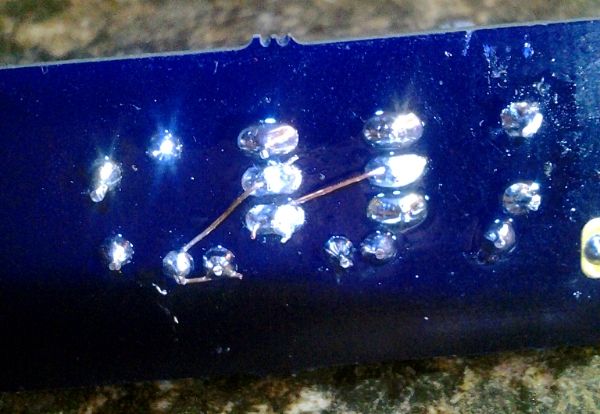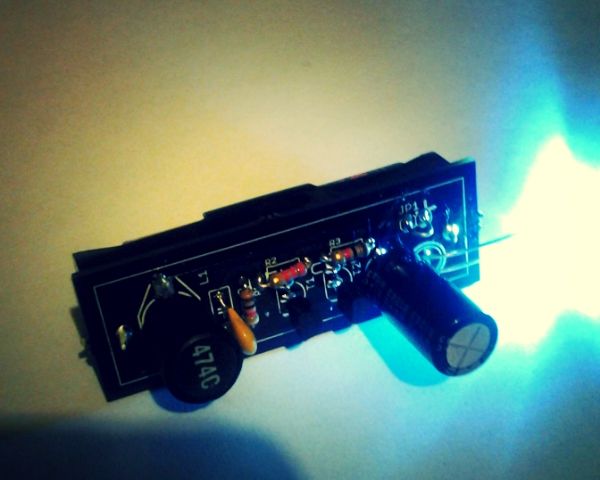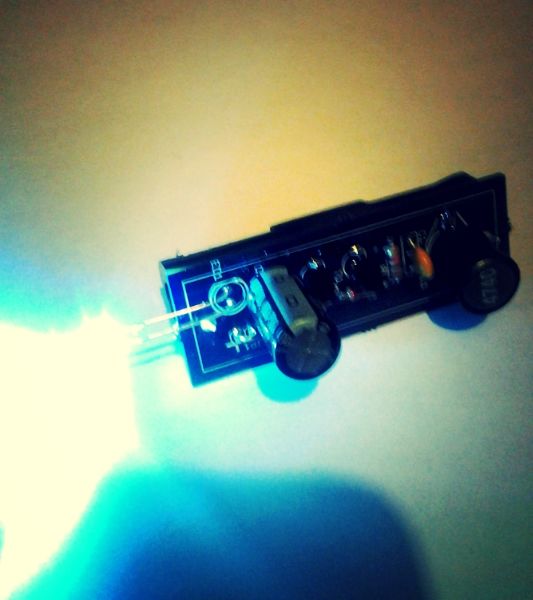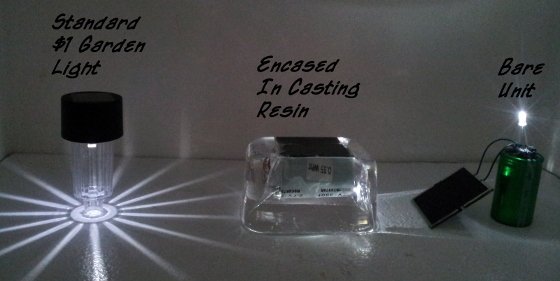Yes, the transistor acts like a booster to step up 1.2V to over 3.6V to light up the LED.
 Is the driver from a single AAA single 5mm led torch (seems an overstatement). Would this be an example of a JT?
Is the driver from a single AAA single 5mm led torch (seems an overstatement). Would this be an example of a JT?
I am not sure. I can only find a diode, an inductor, a capacitor and a transistor or an IC. Can you read the marking on the semiconductor? That is helpful to find out what it is.
Using the stock 14 mm lens as a glass I read CX2501 on the transistor and S4 on the diode. B+ is connected to the transitor and coil. The other side of the coil is connected to the diode and the other pin of the transistor. The led+ is from the diode with the cap across to gnd. And led- is connected to the gnd side if the transistor along with the cap. There is no resistor. As soon as these wires break from playing with it too much I’ll start on the Frankenminilenserclonemod.
I could not find the data sheet of cx2501. I think it is an IC similar to this one.

Probably NOT.
Full disclosure: I have two of these which are different yet similar. One from “Small Sun”, one from “Nebo”. No JTs here either. YET!! Both of these will host my little monsters, someday…
Notice your inductor? (the big black cylindrical thing sticking up between the wires) If I can see it properly (not assured) it appears to have two wires connecting it to the circuit.
A Joule Thief (“Blocking Oscillator”) uses the interaction between two contrary windings on a common core to keep the BOM down. (This is why some people think they’re “magic”, AFAIK — ‘EMF vs. Counter-EMF in the Battle of the Century’) That means at a minimum 3 points of contact to the inductor. One common, one for the Base, one for the Collector & LED. A “pure” JT only uses this “bifilar” transformer, a 3v LED, an NPN transistor and a Base Resistor.
It would benefit you significantly to take the time to trace yours out & draw a schematic of it. At the bottom line, they are making White LED light from a 1.5v cell, so they’re obviously doing SOMEthing right… You can DD your LED from your AA to test that. If you can identify the other parts, oftentimes the datasheet will give you the exact circuit as an example…
OTOH, you could use your parts to MAKE a JT… A secondary winding on your inductor, joined to one end (experiment to see which) would do the trick, if that’s not how it’s already built. Some of the other components will probably be useful too…
Sorry if I’m rambling. Back to work…
Dim
Let me admit to a recent obsession with Joule Thief circuits. I think posting measurements is great.
I think I can explain the behaviours with more than one cell. I think if the input voltage is higher than the series of (or just 1 LED), then battery current will flow without needing any oscillation and indeed oscillation seems to be inhibited. Any flow through the transistor bypasses the LEDs, this is completely pointless if the circuit is not oscillating, and just makes for inefficiency. WPS
Ok, I can explain this too. I tried to push the envelope and used a small toroid from a CFL but used enamelled wire from the same source. Because the wire was so fine, I figured it was possible to make lots of turns, say 50+. The result is a coil with ‘lots’ of inductance. I measured it as about 5 mili Henrys. This means in practice that the circuit oscillates at a lower frequency than it would with fewer turns. This gives a less bright LED, but probably increased efficiency. Less inductance gives a frequency that is higher and above the audible range. Mine is about 9 kHz and interestingly some can hear it and some can not. I tried muffling it with hot melt glue gun glue with some success. The frequency depends on the battery voltage too. It seems to increase in frequency as the voltage runs down. WPS
Thanks for your input, that does indeed make sense!
Oh, and BTW, welcome to BLF!
I would counsel against using a Lithium primary (without careful testing) unless you have more than one LED in series. The point of a Joule Thief is that it boosts the voltage by oscillating. I think you will find a Lithium cell at 3V will make many LEDs conduct at least somewhat on its own, and may inhibit oscillation. I have found higher supply voltages need more base bias i.e. a lower resistor than that which works for a lower supply voltage. I found two NiMH cells in series a) made my white LEDs conduct a bit and b) stopped the circuit from oscillating, when the base resistor was OK for a lower voltage. Two NiMH cells in series gives about 2.6 V. With a lower base resistor value, it did oscillate and get brighter though. N.B. There is NO point in a Joule Thief that is not oscillating or one that does not need to oscillate to light up the LED. The transistor is likely to just ‘bleed’ off power pointlessly if not oscillating.
As there is no series resistor with the LED and the windings are just copper wire, when NOT oscillating, the inductor does NOT inhibit the DC component, therefore, I think, a Lithium cell would probably blow up some single LEDs. Is that clear or am I rambling?
WPS
I have had fun with this circuit. I mean the conventional toroid, transistor resistor type made with recycled parts. I have soldered it up on Vero board. I added 1 component, a light dependent resistor between the base and ground. That has a low resistance in the light and reduces the base drive thus turning off the circuit automatically in the light, by using a tiny screw operated potentiometer, the circuit can be controlled a bit too. The off point can be made quite dim but the brightness optimised too, a 10 k pot was good. When the LDR turns it off and stops it oscillating, you want the base resistor to be high as that is now leakng to ground via the base emitter junction. My transistor has not got hot. In my fiddles, always with 20+ turns on the toroids and 1 battery and 1 LED or a 25 string in parallel, I found less light was associated with less input current and vice versa so it remained ‘efficient’. I have not quantified that efficiency numerically, but when running for days on other peoples cells destined for the tip, that could be said to equal 100%.
My favourite use is for a gentle ‘orientation’ night light for continuous use in the dead of night as it is so dark in my house. My mother had a nocturnal fall and a fracture recently, which sparked my interest. She was at her home at the time but I would have been mortified if it had been here. WPS
Wow! You are breaking trail on a path I am trying to follow. Thank you for sharing.
A friend has a Deck Prism (click) mounted in a beautiful box — with the point upwards & a night light underneath. A lot of people live aboard boats… The idea I had (didn’t work) was to add the “tertiary” Joule Thief winding to drive a 4” Fluorescent Circlite, but XM-Ls have caught up with me. I’d mount the LDR through the side of the box so it could be pointed toward specific light sources like windows or lamps…
Thanks for the kick in the pants, too!
Dim
My other idea was more to do with camping than boats. However, I thought the idea of a dependable light source for extreme conditions required it to be waterproof. I wanted to avoid having a vulnerable switch breaching a sealed body. The LDR approach is good for making it automatic though. Seeing as a JT works with such a small current 25ma or so, I have utilised at tilt switch inside a translucent (very small tough and cheap) sealable food container. The light diffuses through the lid or sides just fine. There is room for spare batteries within too. There is plenty of light for reading or navigating in the dark, but in no way it it a beam device. To turn it off you just turn it over. I use both approaches, so that turning it over cuts off the battery completely but the LDR puts it into a low power state by day.
I have noted worries about leaking batteries, so I stuff the box with paper tissue to shockproof it too. WPS
I know the last post was over 6 months ago but just interested to hear about anyone’s new joule thief projects. I have built one using a 2n3904 and a toroid from a pc motherboard. It is fantastic to be able to use the power normally thrown out. Every drop counts so to speak.
You can also make one that gives you around 1000 volts of AC current. That one can light over 100 LED lights or a fluro tube! There is a thread at overunity.com called “jule thief” and it shows the journey of some guys trying to get the most out of an AA battery.
You can also make earth batteries, galvanic batteries to power a joule thief circuit. You could make lights out of scraps!
Yes, I am still fascinated by these circuits and have built 21 now in different shapes and sizes. I have stuck to the same basic circuit, so they are all JTs. I love the feeling of getting something for nothing, I.e. use out of scrap.
BUT, Please do not spoil them by exaggerated and absurd claims. Ok, I am a pedant but you do not advance anything by your second paragraph! Some of us are irritated by phrases like “Around 1000v of AC current”. Volts prefers to a property akin to pressure and current is akin to flow. Those are different properties like your height and your weight. It is as silly as saying you can make a rocket that is 10 tons fast!
Good JTs are about 60% efficient and so do not achieve over unity. They break no rules but they do give useful light from discarded batteries and electronic bits and bobs and I love them for that.
It is worth remembering that the charm of these circuits is due to the efficiency of LEDs. My house is never pitch dark, since there are several stategic JTs, which I have adapted to turn on automatically. There is a background glow to navigate by at night. I ‘pre-cycle’ other people’s discarded batteries. When I finally recycle them they are really flat. So they might be 1.3 volts when they are installed in the JTs and leave at 0.7 volts.
However, none of them use much power. The LEDs give off useful light at night, when it is dark because they are so efficient and the human eye is so sensitive. I have not managed to make JTs that could give out more than 1 watt. For those who want to try, that’s OK, but for me the ones that glow for the longest are the most satisfying. I have some that run for 3 months on 1 cell, admittedly that was a new D cell. So, I can light my house with JTs at night but not heat my house in winter.
For me the charm is also in their simplicity and oscillation. They have a heart that beats. The electronic LED diode function is much more vital in these circuits than in a simple torch circuit.
Build one and I predict you will want to make another, at least that is what I have found. They are true budget lights but not over unity.
I used my tinfoil hat to bake a potato, so I can’t get to OU.com anymore. That site is like looking for diamonds in the mine. If you know very well what you’re doing, you can occasionally find something useful there, but you’re still going to have to shovel a lot of overburden to get it.
OTOH, “AC current” is redundant anyway…
Oh, and adding windings to the JT’s toroid will get you different voltages, but getting “enough” is going to put you into the ballpark where simply recycling CFL drivers will be cheaper… Speaking purely as an Engineer, extra cost + more work to get ‘x’ == “dumb idea”. Besides, the resulting circuit will be physically too big to justify skimping on the battery, meaning you’d be better off deciding what you want & designing a circuit to do that specific task. If you want to use the last volt of an alkaline battery, you’re on the right track with a Joule Thief. If you want to hand-carry a fluorescent bulb (with a 1-battery circuit), seek professional help.
“Why ask why”? Because that’s what smart people do!
A fluorescent bulb is fragile, awkward and dangerous, not to mention DIM for their size (visualize a 4’ (>1.2m) Arc Flash next to your best 40W FL tube… which one makes your eyes water?). WhyTF would anyone want to light one with a dead AA battery anyway??? Show me how to drive a 4’ Arc from a 1*AA and I’ll become your Apostle!!!
BTW, my rocket is much louder than Thursday, and at least as fast as green, if the AEther is willing. And it goes much higher than 4 acres when the wind is Up. All that on pure DC ohms. It takes a prettier tinfoil hat to get there, but you can trust me, I did it, virtually.
And I’m just…
Dim
Awww… That’s much nicer than my allegory!
I liken the JT to having one bucket but needing to do two buckets-worth of work, so the circuit takes the first bucket & throws it up in the air (into the toroid), scoops up another bucket, then stuffs the 2nd bucket into the LED just as the first bucket is flushing in too…
And NO, I’m not writing this in the bathroom!!!
Wait ’til you start delving into Ferrite Properties to get “the right” toroid for your design! There’s a huge amount of “magick” re: Materials (all in the toroid shape, just to KISS) which most people don’t even ken, nevermind design for. Take two differently colored (color codes usually indicate Material) toroids, wind them identically, and test. Big difference, huh? Yes, it’s true, you can make a JT exactly precisely perfectly and still have it NOT WORK if you get the wrong Ferrite Toroid!!! (It’s all about the Inductance-per-turn, not just the number of turns)…
But mostly if the Joules in the primary are comfortable pushing their neighboring Joules in the secondary, and the transistor and LED are happy, the resistor will explode because resistors really hate it when we anthropomorphize them! The wires, of course, couldn’t care less…
I went a different route...running great...VERY bright on a 14kcd 5mm LED
I found a really cool joule thief build with an open source shared .brd file
http://www.alxsmith.talktalk.net/HowTo/011JouleThief.html
Uploaded to OSHPark and got the boards and components...small problem, it wouldn't work, until after I contacted the original designer
V1.0 missing traces https://oshpark.com/shared_projects/usJG9Oof
V1.1 fixed and running great https://oshpark.com/shared_projects/Pv0rRfN6
Turns out he used an old version of Eagle CAD and on the parsing of the .brd file at OSHPark it dropped a few of the traces, he went back and corrected it and now V1.1 works awesome...in the mean time I did a bit of trace fixing on my boards that were missing traces...and VIOLA, at .9vdc running a 14kcd 5mm LED just as bright as a full charge 1.5vdc battery, these things are quite bright and provide more than enough light to see and get around if there was no other light source available
My trace fix

Sorry my soldering is horrible because I had to redo them about 4x times!
And shots of it running


All parts except box and jumper push button Digi-Key
1 3 BCAAPC-ND HOLDER BATTERY AA PLASTIC PC MNT 3 0 0.92000 $2.76
2 6 CF14JT1K00CT-ND RES 1K OHM 1/4W 5% CARBON FILM 6 0 0.08000 $0.48
3 3 CF14JT2K20CT-ND RES 2.2K OHM 1/4W 5% CARBON FILM 3 0 0.08000 $0.24
4 3 1285PH-ND CAP CER 470PF 1KV 10% RADIAL 3 0 0.24000 $0.72
5 3 493-12814-1-ND CAP ALUM 100UF 100V 20% RADIAL 3 0 0.43000 $1.29
6 3 811-1312-ND INDUCTOR RADIAL 470UH 0.60A 3 0 1.42000 $4.26
7 6 BC548BU-ND TRANSISTOR NPN 30V 100MA TO-92 6 0 0.21000 $1.26
Subtotal $11.01 (for 3x complete sets)
Speaking of solar power sun jars
I came across this, you might be interested in

This guy uses a supercapacitor, seals it inside the clear polyurethane encapsulant resin, thing will run for DECADES!